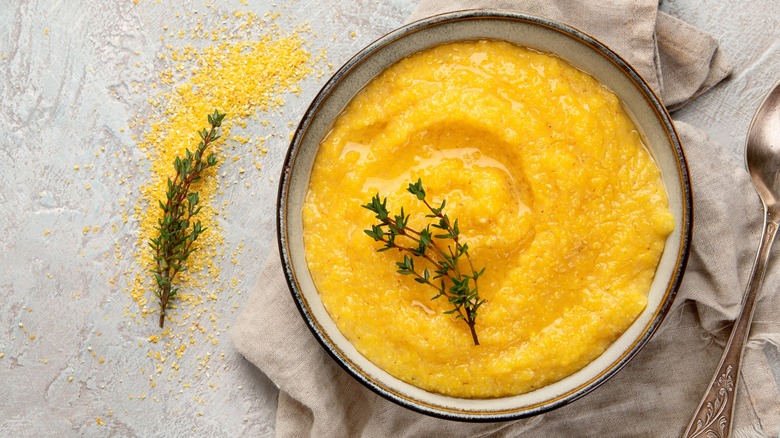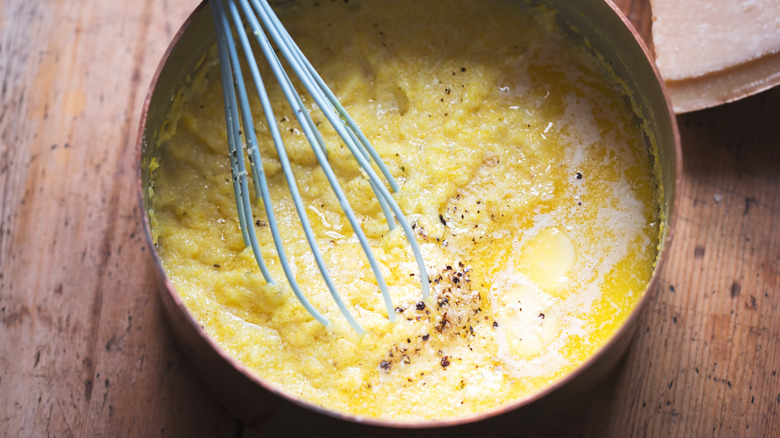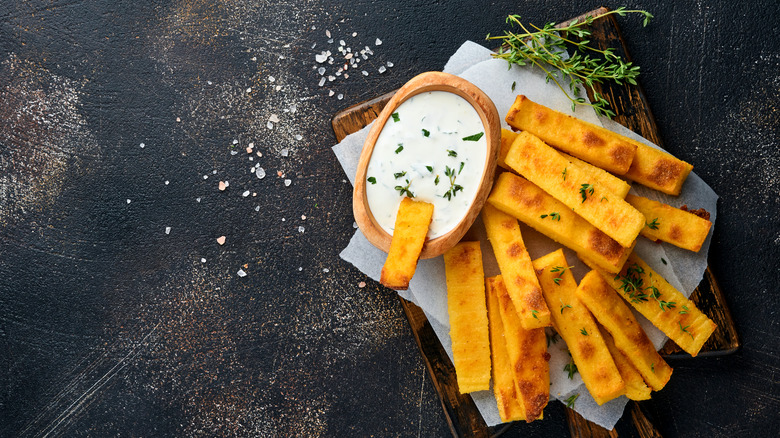For Creamier Polenta In Half The Time, Break Out The Baking Soda
Polenta is both a comfort food staple and a versatile option to add to your household's meal or side dish repertoire. With roots in Northern Italy, polenta is made from ground corn simmered in four to five times the amount of salted boiling water, cream, or stock. After it is cooked to sweet, creamy perfection, some cooks like to remove the pan from heat and add in a few pats of butter, parmesan, or black pepper to elevate the flavor. The resulting smooth mash has a texture similar to thick porridge.
What makes Italian-style polenta unique is the type of corn and the size of the granules. Polenta is traditionally made with a hard, coarse-ground yellow corn (with granules about the size of couscous). Grits, meanwhile are commonly made with softer, finer grinds of corn. Due to the surface area and hearty nature of the corn pieces, polenta is notorious for taking a while to prepare, in a process that involves cooking the grains for 30-40 minutes in a saucepan, stirring and whisking frequently. For this reason, many people avoid making polenta or use finer polenta grains or pre-cooked instant versions of the ingredient for a quick solution.
For optimal texture and flavor, however, it's best to use the coarse-ground classic. Luckily, there's a tried-and-true trick to speed up the process and still produce a super-creamy polenta. Simply add a bit of baking soda to cut the cooking time in half.
Baking soda helps with gelatinization of the starches
Adding just a small amount of baking soda (about 1/8th teaspoon) to your boiling liquid can reduce your polenta cooking time and produce a more luxurious texture. You likely know baking soda (also called by its scientific term, sodium bicarbonate) as a leavening agent commonly used in various cake, muffin, and cookie recipes. But it's also a go-to ingredient when it comes to the softening and express-cooking of beans, legumes, and in this case ground corn for polenta.
The way baking soda produces carbon dioxide in the oven during baking has to do with the interaction of its alkaline pH with more acidic ingredients when exposed to heat. Similarly, when baking soda is added to the boiling water or cream used to make polenta, it produces compounds that heighten the pH of the liquid. It acts to break down the corn's pectin, the structural element which holds together the cell walls of the hearty granules. This speeds up a process referred to as gelatinization, in which the starch from the corn is released as the corn granules pick up water and swell.
The result is a thickened slurry that will eventually form a cohesive, smooth polenta once the grains are fully hydrated and cooked.
When to add the baking soda
Add a dash of baking soda into your boiling water, cream, or stock along with salt, just prior to stirring in the polenta granules, when the baking soda is most active and potent. Depending on your recipe, you may get a wrist workout and stir the polenta consistently throughout the cook time.
You can also opt for more hands-off methods, which require stirring vigorously in the first minute and then whisking to remove any lumps before covering your saucepan and letting the polenta cook on low for the remaining cook time. Either way, simply tossing in baking soda to the hot liquid upfront cuts the cook time and gelatinization process in half.
Polenta can be served in its soft, creamy form right out the pan, or it can be chilled to a firm texture and cut into cubes or strips to be baked, seared on the grill, or made into polenta fries. Using the baking soda method, try your hand at hearty dinner recipes such as creamy polenta with sausage crumbles, or serve polenta as an alternative to mashed potatoes.


